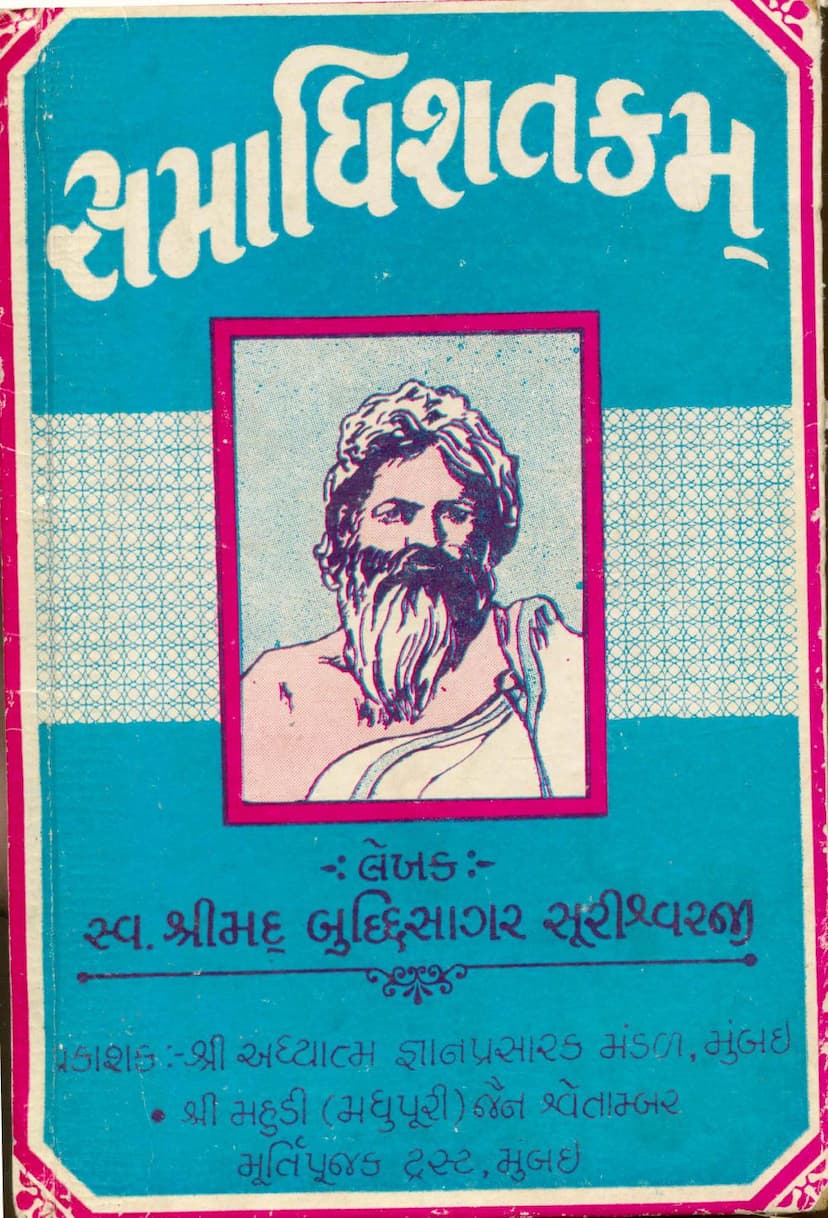Samadhishatakam
Added to library: September 2, 2025

Summary
Here's a comprehensive summary of the Jain text "Samadhishatakam" by Buddhisagarsuri, based on the provided Gujarati pages:
Overall Purpose and Context:
"Samadhishatakam" (समाधिशतकम्) is a Jain text that delves into the path of achieving true happiness and liberation (moksha) through spiritual knowledge and practice. The book, as presented here, is a Gujarati translation and commentary on an original Sanskrit work. The commentary is provided by Acharya Buddhisagarsuri, a renowned Jain scholar and yogi. The text emphasizes the importance of self-realization and detachment from worldly pleasures.
Key Themes and Concepts:
-
The Nature of Suffering and Liberation: The text begins by explaining that the soul (jiva) wanders through the cycle of birth and death (samsara) across four realms of existence due to karma, experiencing endless suffering. Liberation (moksha) is attained by destroying karma.
-
The Path to Liberation: The Tirthankaras have prescribed the path of self-realization through both Vyavahar Naya (conventional/practical truth) and Nishchay Naya (ultimate/essential truth). Vyavahar Naya maintains the continuity of the four-fold Jain community (sangha), while Nishchay Naya leads to entry into the true nature of the soul.
-
Anekantavada and Syadvada: The text highlights the Jain principle of Anekantavada (non-absolutism) and Syadvada (the doctrine of conditional predication). Understanding the multi-faceted nature of reality (Saptabhangi) helps to eradicate mistaken beliefs and prejudices (mithyatva).
-
The Importance of Adhyatma Jnana (Spiritual Knowledge): True and lasting happiness (samadhi) can only be achieved through spiritual knowledge. This knowledge helps to shed the externalized consciousness (bahirātmabhava) and turn the mind towards the self (ātmā). Neglecting spiritual knowledge while focusing solely on worldly practices is a mistake.
-
The Unity of Knowledge and Action: Liberation is achieved through the combination of knowledge (jnana) and action (kriya). Knowledge without action is incomplete, and action without knowledge is fruitless. Both must be practiced together.
-
The "Samadhishatakam" Text:
- The original "Samadhishatakam" was written in Sanskrit by Acharya Pujyapad (also known as Prabhachandra or Sambhandhudha) of the Digambara tradition.
- A commentary was written on this Sanskrit work by Acharya Prabhachandra.
- Significantly, Acharya Yashovijayji Upadhyaya, a prominent Śvetāmbara scholar, translated and adapted the core ideas into Gujarati verse (Doha), creating a "Gujarati Shatak" for the benefit of common people.
- Acharya Buddhisagarsuri has provided a commentary on this Gujarati adaptation, enriching it with deeper spiritual insights and explanations.
-
The Meaning of "Samadhi" and "Shatakam":
- Samadhi: The text explores various interpretations of "samadhi," including peace, equanimity, bliss, mental tranquility, and, in a technical sense, the concentration of the mind, the destruction of karmic influx, and the state of perfect equanimity. It is linked to spiritual absorption and the attainment of knowledge.
- Shatakam: This refers to a composition of a hundred verses. The "Samadhishatakam" is a collection of a hundred verses focused on achieving samadhi.
-
The Nature of True Happiness (Ananda): True happiness is inherent in the soul itself and is not an external object. It cannot be bought or taken as medicine. It is an intrinsic quality of the soul's pure consciousness.
-
Distinction between Outer and Inner Self: The text elaborates on the three aspects of the self:
- Bahirātmā (External Self): One who identifies with the body, senses, and external objects. This leads to suffering and attachment.
- Antarātmā (Inner Self): One who understands the soul's distinction from the body and senses, and focuses inwards. This is the path towards liberation.
- Paramātmā (Supreme Self): The fully liberated soul, free from all karmas and experiencing infinite knowledge, perception, bliss, and power.
-
The Illusion of the External World: The text repeatedly emphasizes that worldly possessions, relationships, and experiences are transient and ultimately illusory. Identifying with them leads to suffering. The enlightened person sees through this illusion, recognizing the soul's true, unchanging nature.
-
The Role of the Guru: The importance of a spiritual guide (guru) is implicitly and explicitly mentioned as essential for understanding the true nature of the soul and the path to liberation.
-
The Interplay of Knowledge and Experience: While intellectual knowledge of scriptures is important, it is the direct experience and internalization of this knowledge (anubhava) that leads to true spiritual transformation.
-
The Meaning of Liberation (Moksha): Moksha is the state of ultimate freedom from karma and rebirth, characterized by infinite bliss, knowledge, and perception. It is achieved by eradicating the soul's connection with karmic matter.
Commentary Style and Content:
- The commentary by Acharya Buddhisagarsuri is detailed and explanatory, often quoting other Jain scriptures and philosophical texts to elucidate the verses.
- It provides interpretations of key terms, concepts, and the underlying philosophical arguments.
- The commentary also offers practical advice on spiritual practices and the importance of maintaining equanimity and detachment.
- The text includes devotional elements, with prayers and salutations to the Siddha souls and Tirthankaras.
Overall Message:
"Samadhishatakam" guides the reader on a spiritual journey from the suffering of worldly existence to the ultimate bliss of liberation. It emphasizes the power of self-knowledge, detachment, and consistent spiritual practice, highlighting that the path to true happiness lies within the soul itself. The commentary serves as a valuable guide for understanding and applying these profound teachings in one's life.